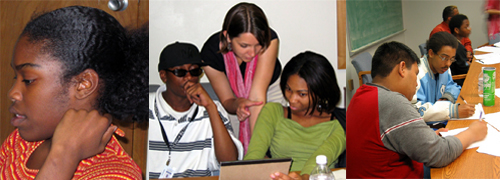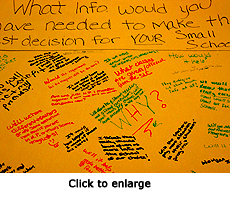
INDIANAPOLIS, IN—"Here's the hard truth," high school junior Ronald begins. "Indianapolis schools has the fifth worst graduation rate in the country. Only twenty-five percent of black males who enter high school here get a diploma. We have more black males in prison than in college."
Monica, his classmate at Indianapolis's Broad Ripple High School, joins in. "We have too many students who don't care, too many teachers who have given up, too many low expectations filling the hallways."
"We aren't saying there is nothing good going on," says Che, another student. "But there's so much that's wrong."
Northwest H.S. students reflect on the project "Once this is all done, I worry that we're not going to be listened to anymore. They'll stop involving students. But there's another part of me that says, hey, at least they are involving students, at least they're having us present our findings at high level meetings. It's a start." |
|---|
Their views may sound impossibly dismal, but these students are describing a difficult situation they know well—based both on their own feelings and on a lengthy process of survey research. Che, Monica, and Ronald are part of a team of students that spent the past year surveying classmates and teachers at their high school as part of a larger initiative.
Two years ago, Indianapolis Public Schools won a grant from the Bill & Melinda Gates Foundation to break its five large high schools into small schools. The nearby Harmony Education Center and its staff of VISTA volunteers introduced a novel idea: to involve students in the redesign process. By pooling their data with student research teams from the city's four other large high schools, they would be able to get an important read on the process. The students learned research and facilitation skills in after-school meetings and in training sessions that brought all five research teams together from across the city.
"Many people think it's incredible that we're including students as partners in improving their schools," notes Megan Howey, the program's VISTA coordinator. "What I find incredible is the notion of redesigning high schools without student input."
Far from being rubber stamps, the project's fifty student researchers, freshmen through seniors, have asked tough questions. What evidence do we have from other cities that breaking large high schools into small schools really works? Are small schools the only way to personalize learning? How can a school change when many of its teachers do not?
Collecting data and pushing debate
The signs of school failure in Indianapolis seem overwhelming: from low test scores to high dropout rates, they mirror troubled urban districts around the country. The student researchers began their work by studying these statistics in detail, taking the full measure of how Indianapolis schools stacked up nationally. They found themselves ranked near the bottom on almost every count. Working with staff at the Center for Excellence in Leadership of Learning (CELL) and the Harmony Education Center, they developed a plan for gathering data in each of their schools that would explain these failures.
"We started off surveying as many students and teachers as we could in our schools, using surveys from the Gates Foundation," Manual High School junior Brittany explains. "The questions were about almost every aspect of school—expectations, relationships, courses, attitudes. We put a lot of effort into getting everyone to understand why they should fill out the survey. We wanted our data to be valid." Almost 60 percent (4,149) of the district's high school students completed the survey.
 After students tallied and analyzed the survey data, they took the results back to their individual schools. An important aspect of the project was fostering a school-wide dialogue. Teams developed their own strategies for creating discussion around their findings. At Manual, student researchers led homeroom discussions around five questions of their choosing. At Arsenal Tech, students posted survey results on the school cafeteria walls, along with blank poster boards where students and teachers could register their reactions. They hosted an open forum after school and made classroom presentations.
After students tallied and analyzed the survey data, they took the results back to their individual schools. An important aspect of the project was fostering a school-wide dialogue. Teams developed their own strategies for creating discussion around their findings. At Manual, student researchers led homeroom discussions around five questions of their choosing. At Arsenal Tech, students posted survey results on the school cafeteria walls, along with blank poster boards where students and teachers could register their reactions. They hosted an open forum after school and made classroom presentations.
"These are serious issues that need to be taken seriously," says Arsenal Tech student Bernard. "We didn't want them hidden."
The students also created strategies for testing their classmates' knowledge of small schools, and their confidence in their power as an antidote to the failing educational system. They led peers in "chalk talks"—silent conversations in which participants write their answers to a question on a large sheet of paper, and then respond to each other's messages, adding new questions and often suggestions. At Arlington High School, student researchers placed poll boxes around the school, asking questions like "What do you or don't you understand about small schools?" Manual students created displays for four different "model" small schools and asked classmates to vote on which they preferred.
 The students at Arsenal Tech also created a huge quilt from individual fabric squares dedicated to a student they knew who had dropped out. "Patricia, you had a lot of potential and I wanted you to become the best you could be," writes one. "School is the gateway drug," states another.
The students at Arsenal Tech also created a huge quilt from individual fabric squares dedicated to a student they knew who had dropped out. "Patricia, you had a lot of potential and I wanted you to become the best you could be," writes one. "School is the gateway drug," states another.
Being heard
"Getting honest conversations going in individual schools, about what needs attention and the role small schools can play, was half the battle," explains coordinator Megan Howey. Bringing the student researchers' findings to the attention of school district leaders and planners, who could actually implement changes on the institutional level was the other half.
In December 2004, the five student research teams presented their survey results to a meeting of district leaders and members of a newly established "network learning community." They felt well received, but as Northwest student Toya notes, "it's not what they say—'Oh, how nice that students did this!'—but what they do that matters." Other district wide forums have noted the students' findings.
Broad Ripple H.S. student speaks about small schools and change "It has to start with the students. If the whole point of small schools is to make learning more personal to the student, well nobody knows better how we learn than us. We also know that students learn best when they feel involved." |
|---|
Still, the students worry that their voices do not count. The principal at one of the five schools removed the survey results students had posted on the cafeteria walls, saying that they disturbed the faculty. The student researchers have gained a keen sense of what makes a teacher worth listening to and can identify and describe the teachers that inspire them in an instant, just as they can pick out the teachers, perhaps demoralized themselves, who regularly demoralize students. But identifying good and bad teachers by name, so that they can be held accountable or get the support they need "gets you into trouble real fast," observes Toya.
Giving school redesign the benefit of the doubt
The most difficult issue of all for the student teams has been coming to terms with the plan to break their large high schools into small schools. They are quick to point out that it is a "done deal," an enormous decision made before their input was invited. After a year of research and discussion, the student team at Manual is the only one coming down squarely in favor of small schools. The first phase, dividing into small learning communities without the autonomy and full distinctiveness of a small school, has gone well at Manual, supporting their positive view. (This fall, actual small schools will take the place of small learning communities in all five high schools.)
 But the other student teams are skeptical. Feedback from classmates underscores how little students understand small schools; on the survey students at Northwest completed, a half did not know what small learning community they belonged to. Students worry especially about the impact small schools will have on existing friendships and course offerings.
But the other student teams are skeptical. Feedback from classmates underscores how little students understand small schools; on the survey students at Northwest completed, a half did not know what small learning community they belonged to. Students worry especially about the impact small schools will have on existing friendships and course offerings.
Several of the student researchers question the capacity of their schools to carry out the transformation, regardless of its merits. "I began the year not knowing a lot about small schools and figuring they were good," explains one Northwest student. "The more I've learned, the more I worried. I don't question the idea, I question the ability of a school like ours, with all of its troubles, to pull off small schools in a way that doesn't make matters worse. What's to say that we won't go from being one large broken school to ten small and even more broken schools?"
Despite these misgivings, Indianapolis's student researchers are giving high school redesign in Indianapolis the benefit of the doubt. They want it to work, they say, and pledge to help make it work, including pushing the need for ongoing discussion. One tool in their campaign is a documentary video they are producing from video footage of classroom conversations they led over the year. They hope it will educate peers about small schools, covering their virtues as well as liabilities.
True to their age, these students are at once critical and idealistic. "Transformation and redesign, that's lofty language," says Northwest junior Isaiah. "But I'm all for it."
Click below to:
Download (PDF) a sample of early planning documents.
Download (PDF) IPS student survey materials.
Download (PDF) results from the student surveys.
Read reflections on the project from Northwest High School students.
Read what one Broad Ripple High School student says about small schools and change.




